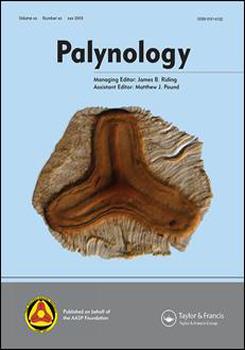In marine sediments of late Cenozoic age, Spiniferites is a very common genus of dinoflagellate cysts (dinocysts). Despite some taxonomical ambiguities due to large range of morphological variations within given species and convergent morphologies between different species, the establishment of an operational taxonomy permitted to develop a standardized modern database of dinocysts for the midhigh latitudes of the Northern Hemisphere. In the database that includes 1490 surface sediment samples, Spiniferites mirabilis-hyperacanthus, Spiniferites ramosus and Spiniferites elongatus were counted in addition to Spiniferites belerius, Spiniferites bentorii, Spiniferites bulloideus, Spiniferites delicatus, Spiniferites lazus and Spiniferites membranaceus. Among these taxa, Spiniferites mirabilis-hyperacanthus, Spiniferites ramosus, and Spiniferites elongatus are easy to identify and are particularly common. Spiniferites bentorii and Spiniferites delicatus also are morphologically distinct and occur in relatively high percentages in many samples. Spiniferites lazus and Spiniferites membranaceus also bear distinctive features, but occur only in a few samples. The identification of other taxa (Spiniferites belerius, Spiniferites bulloideus, notably) may be equivocal and their reported distribution has to be used with caution. The spatial distribution of Spiniferites species, with emphasis on the five most common taxa, is documented here with reference to hydrography (salinity and temperature in winter and summer, sea ice cover), primary productivity and geographical setting (bathymetry, distance to the coastline). The results demonstrate distinct ecological affinities for Spiniferites elongatus, which has an Arctic-subarctic distribution and appears abundant in low productivity environments characterized by winter sea ice and large temperature contrast between winter and summer. Spiniferites mirabilis-hyperacanthus, which occurs in warm temperate water sites, is more abundant in high salinity environments. It shares its environmental domain with Spiniferites bentorii, which appears to have a narrower distribution towards the warm and high salinity end of the Spiniferites mirabilis-hyperacanthus distribution. In contrast, Spiniferites delicatus, which occurs in warm-temperate to tropical environments, shows preference for relatively low salinity and low seasonal contrasts of temperature. Spiniferites ramosus exhibits a particularly wide distribution that overlaps both cold and warm Spiniferites taxa. Its cosmopolitan occurrence and its long-ranging biostratigraphical distribution suggest a high plasticity of the species and/or cooccurrence of several cryptic species. Hence, whereas Spiniferites elongatus and Spiniferites mirabilishyperacanthus are useful palaeoecological indicators despite their large morphological variability, Spiniferites ramosus is a taxon with an unconstrained ecological significance.
How to translate text using browser tools
1 December 2018
Distribution and (Palaeo) Ecological Affinities of the Main Spiniferites Taxa in the Mid-High Latitudes of the Northern Hemisphere
Anne de Vernal,
Frédérique Eynaud,
Maryse Henry,
Audrey Limoges,
Laurent Londeix,
Jens Matthiessen,
Fabienne Marret,
Vera Pospelova,
Taoufik Radi,
André Rochon,
Nicolas Van Nieuwenhove,
Sébastien Zaragosi
ACCESS THE FULL ARTICLE
It is not available for individual sale.
This article is only available to subscribers.
It is not available for individual sale.
It is not available for individual sale.

Palynology
Vol. 42 • No. S1
December 2018
Vol. 42 • No. S1
December 2018
Dinocysts
palaeoceanography
productivity
Quaternary
salinity
sea-ice
temperature




